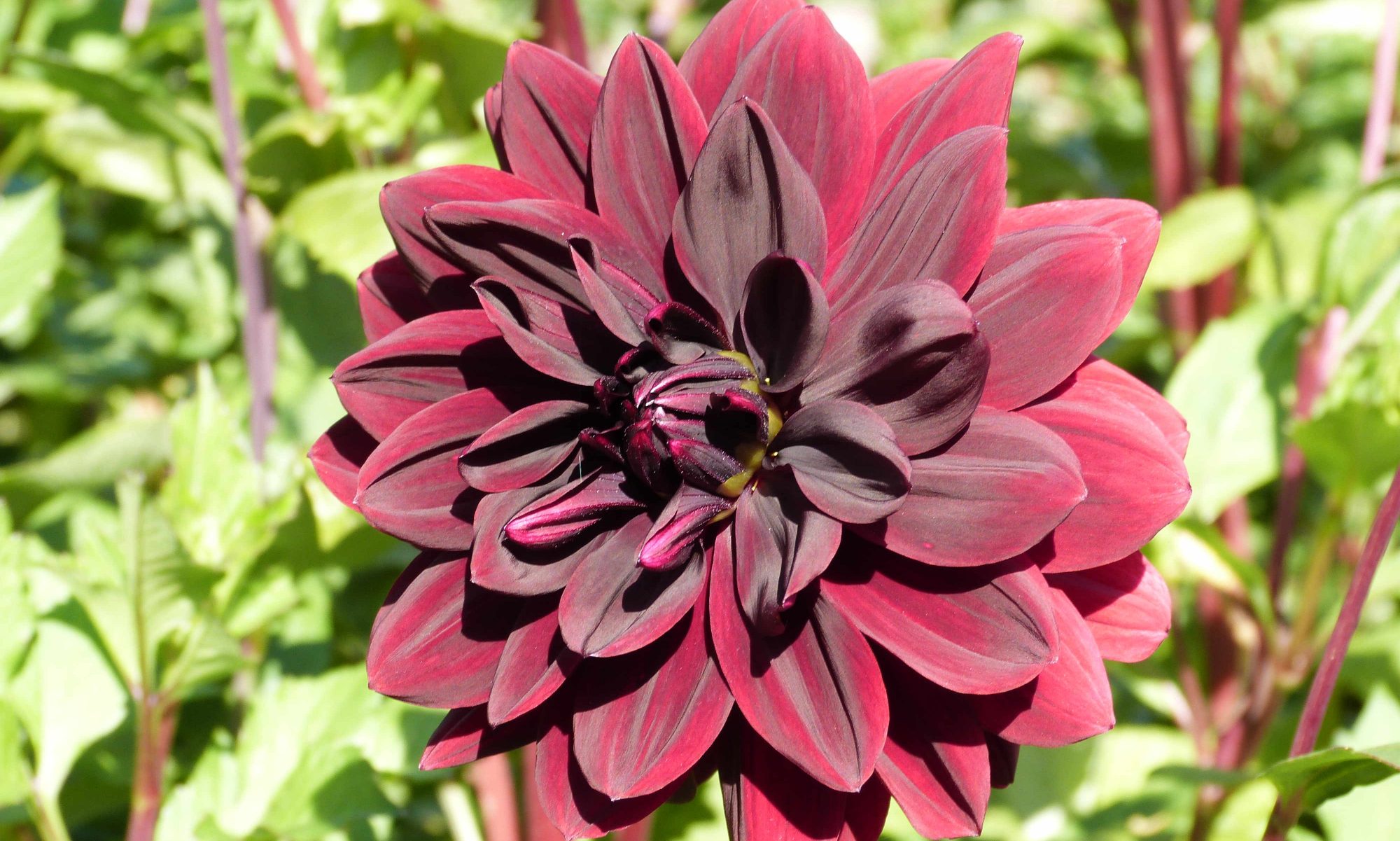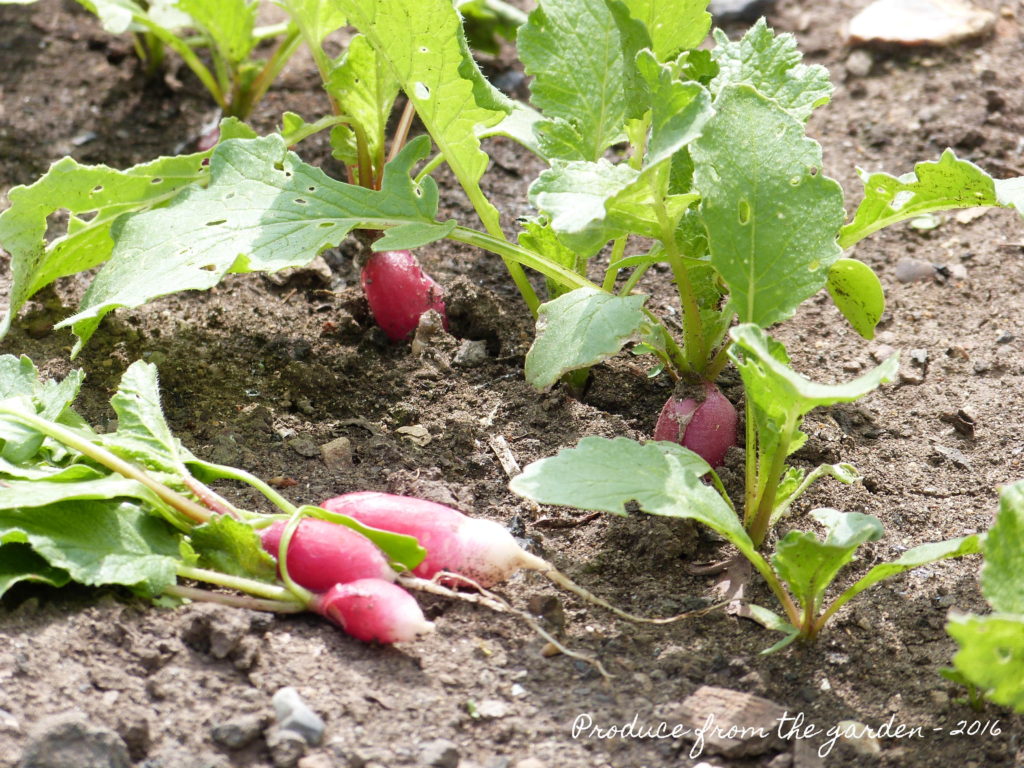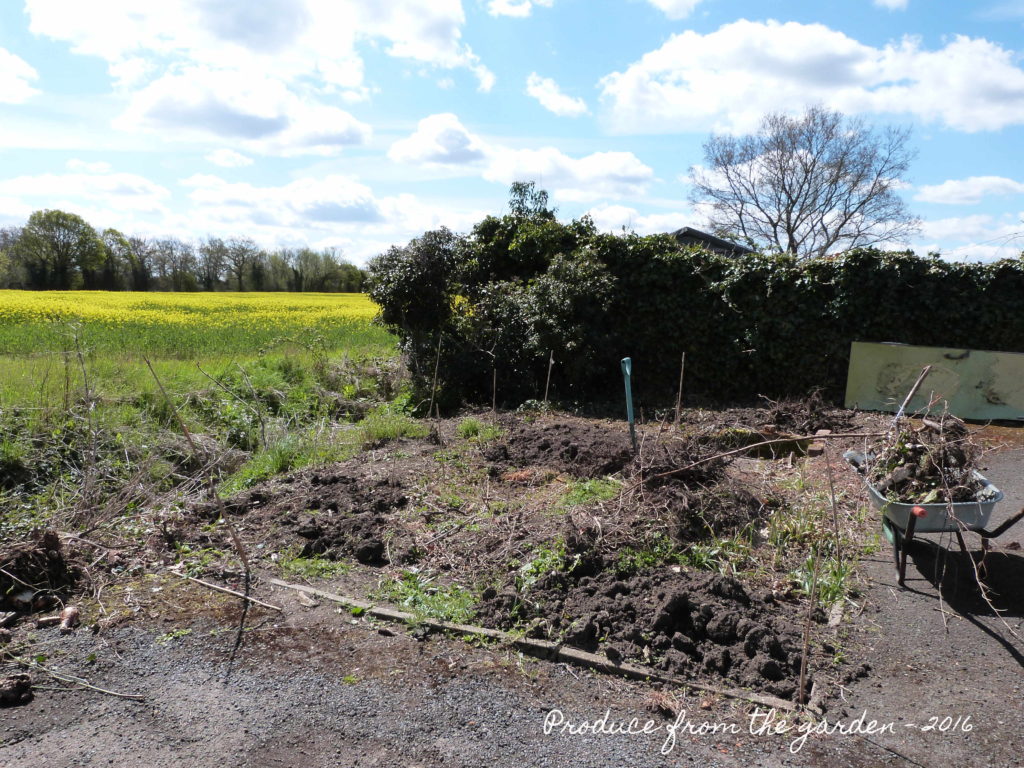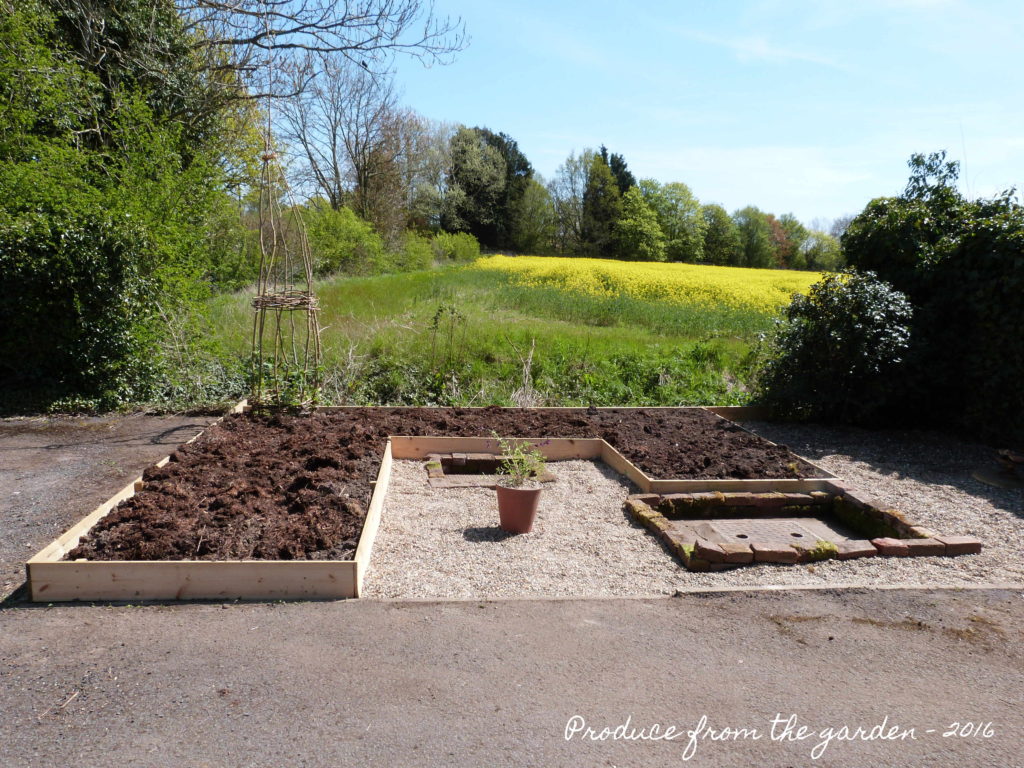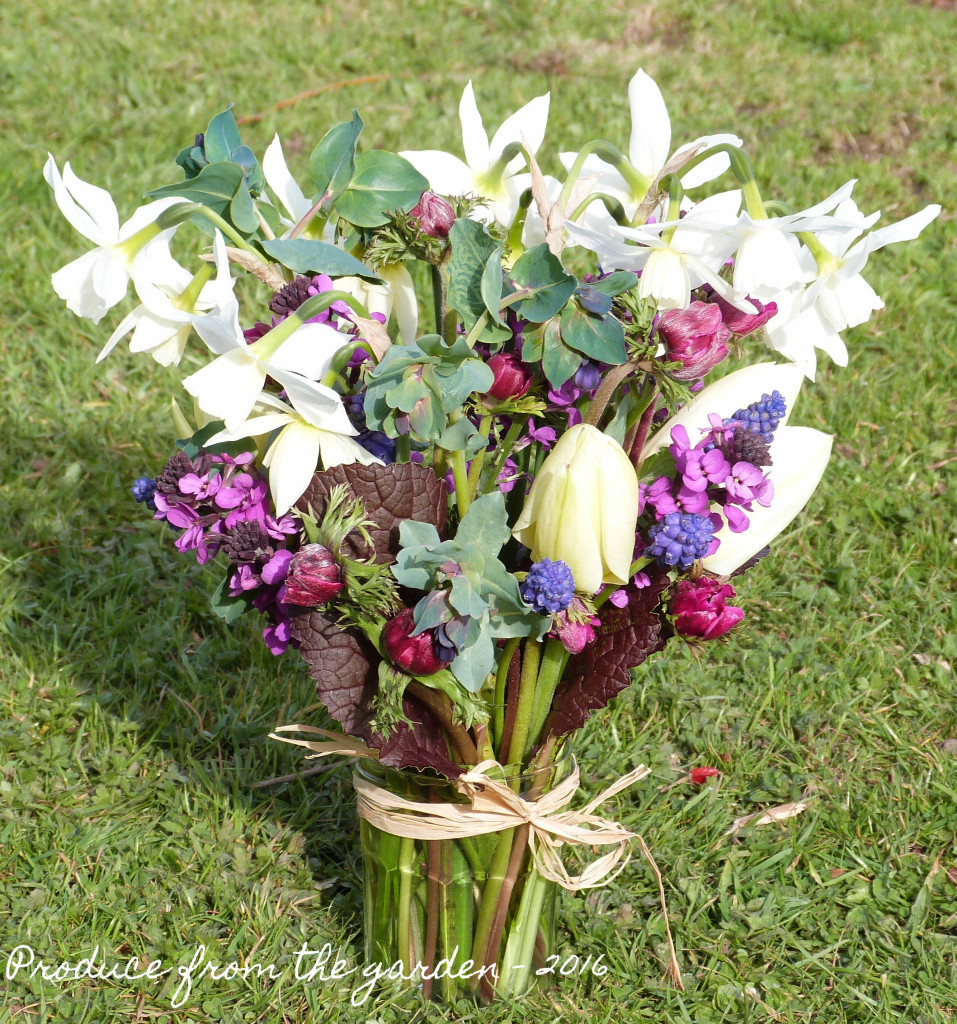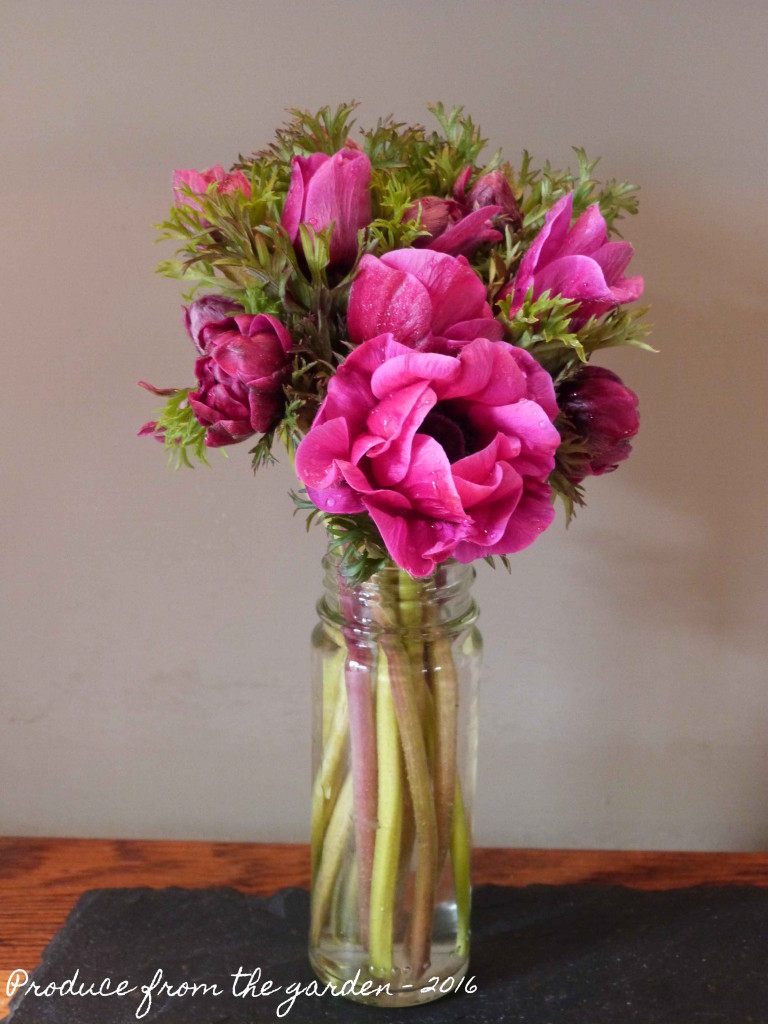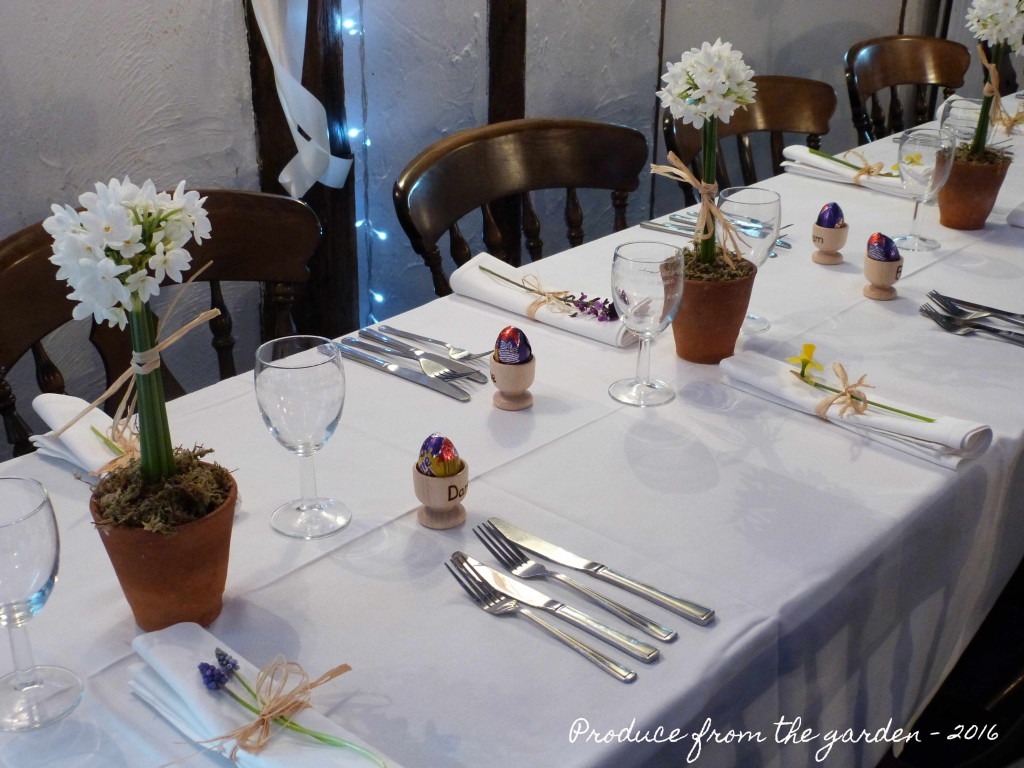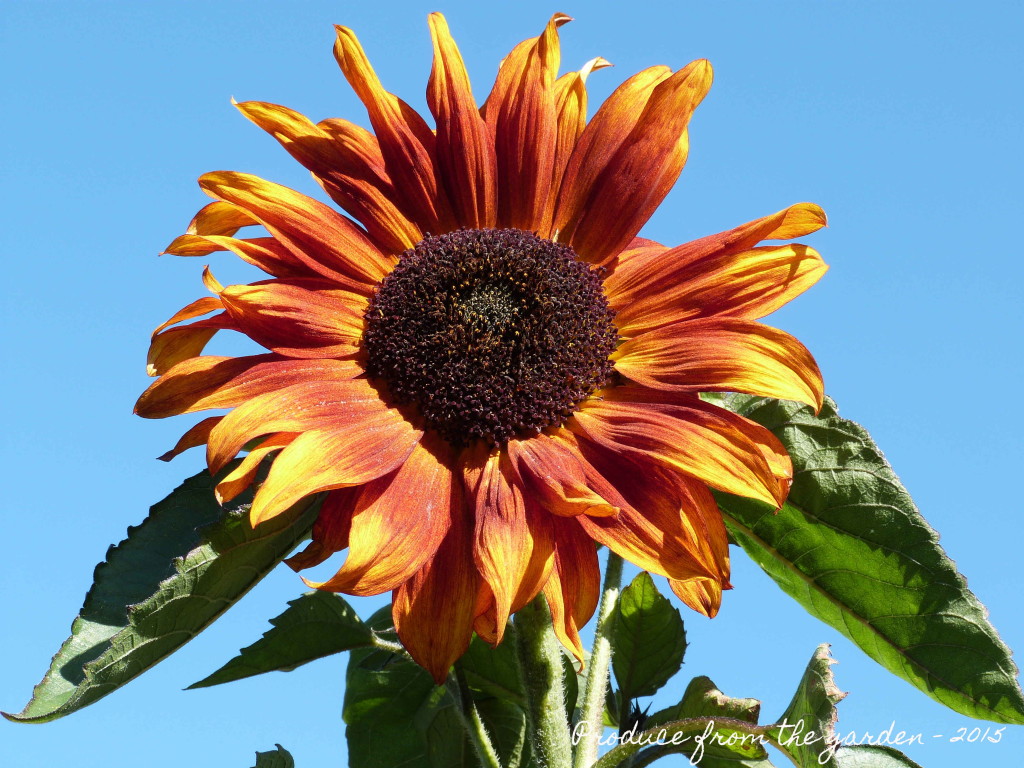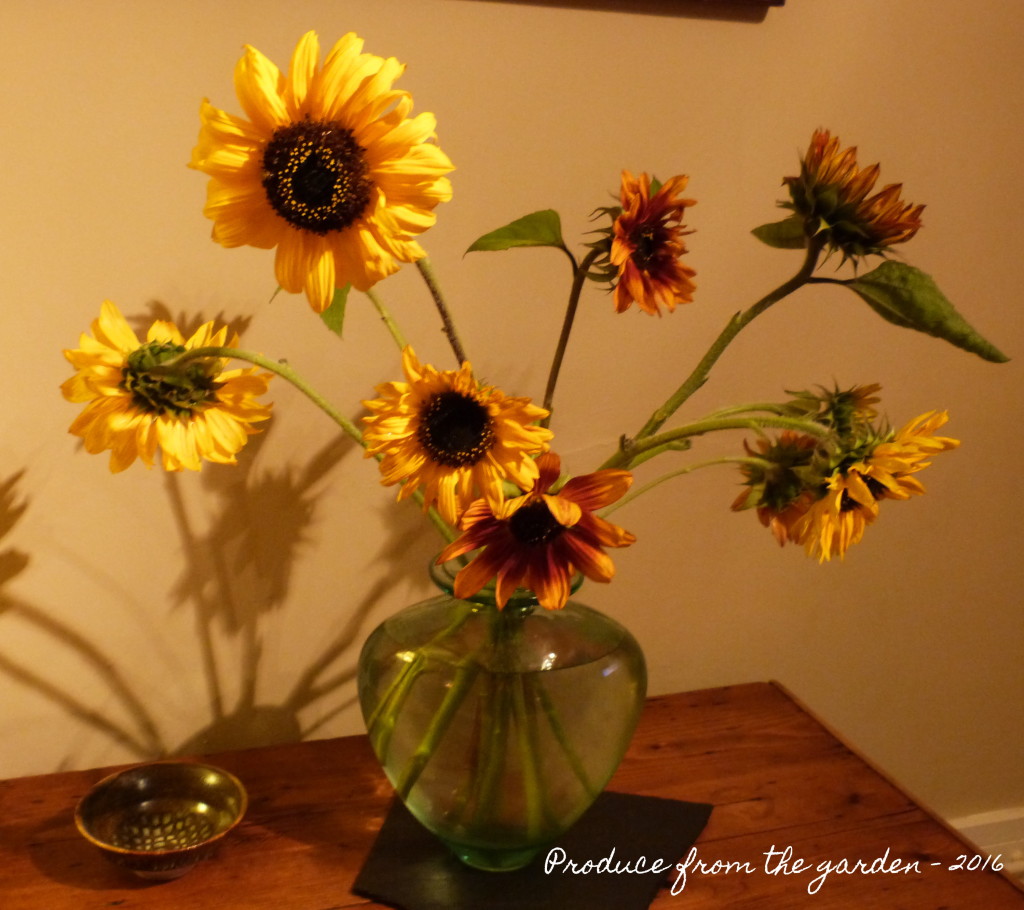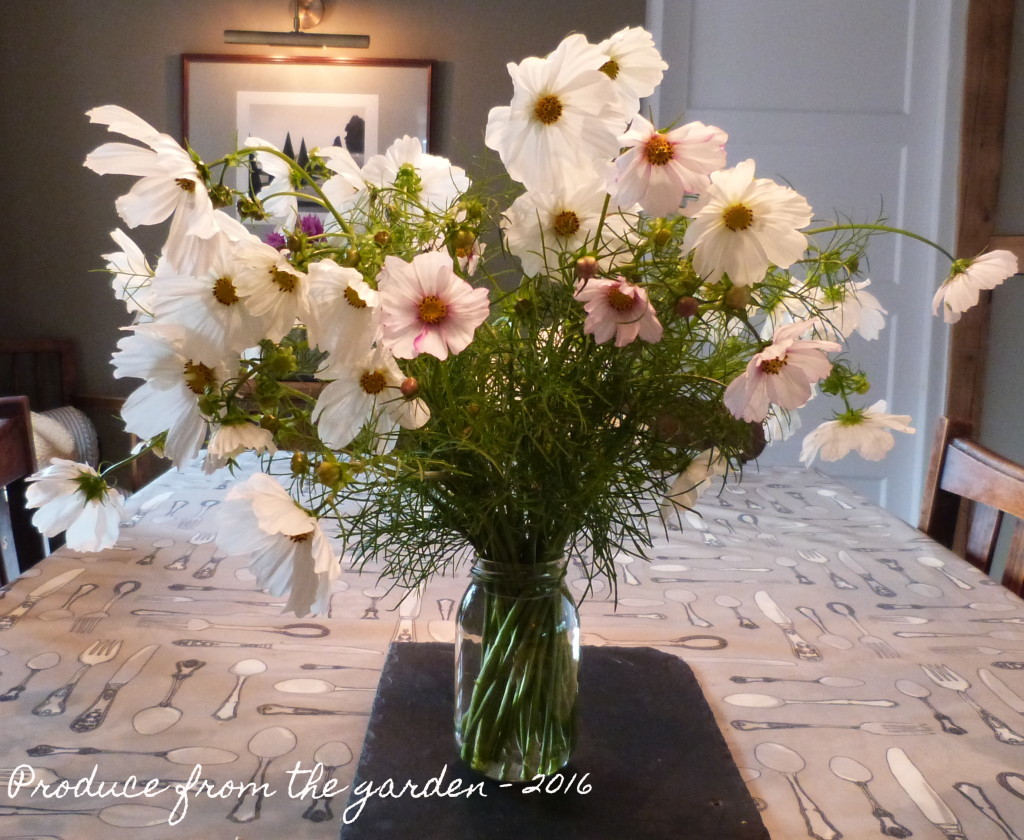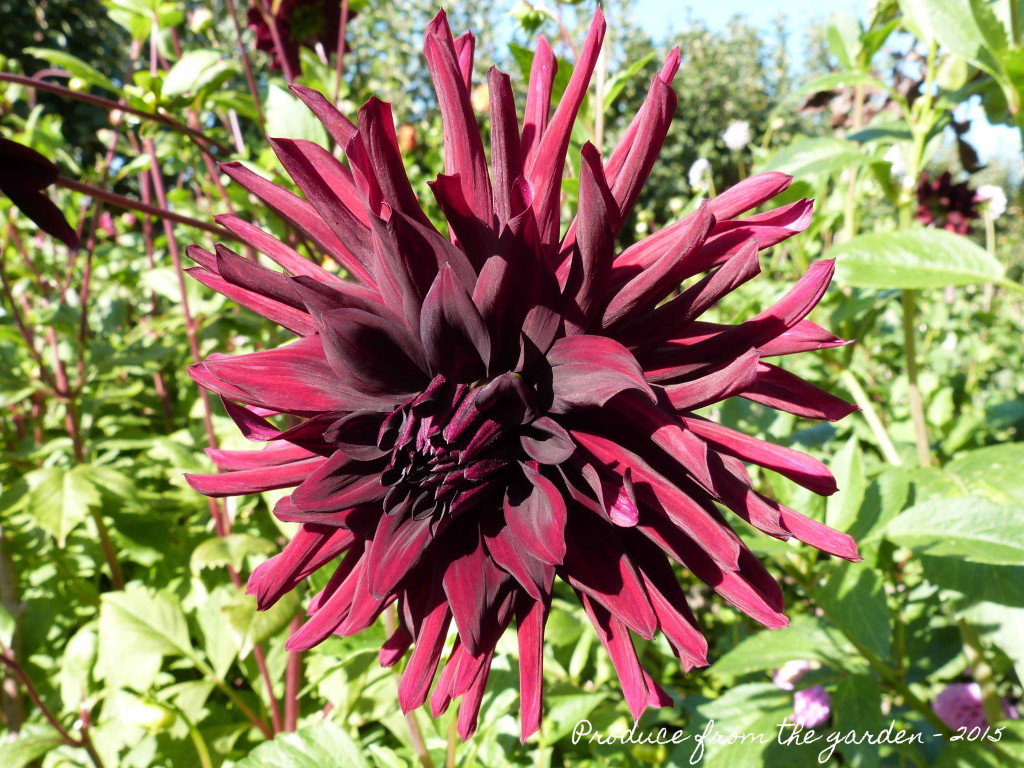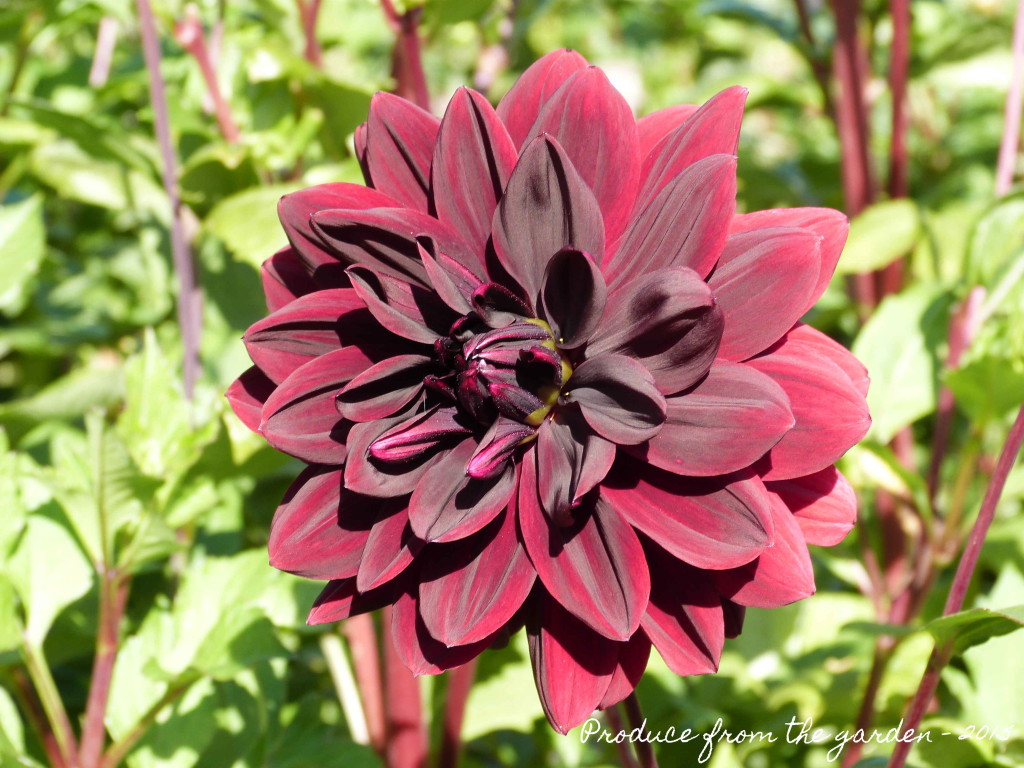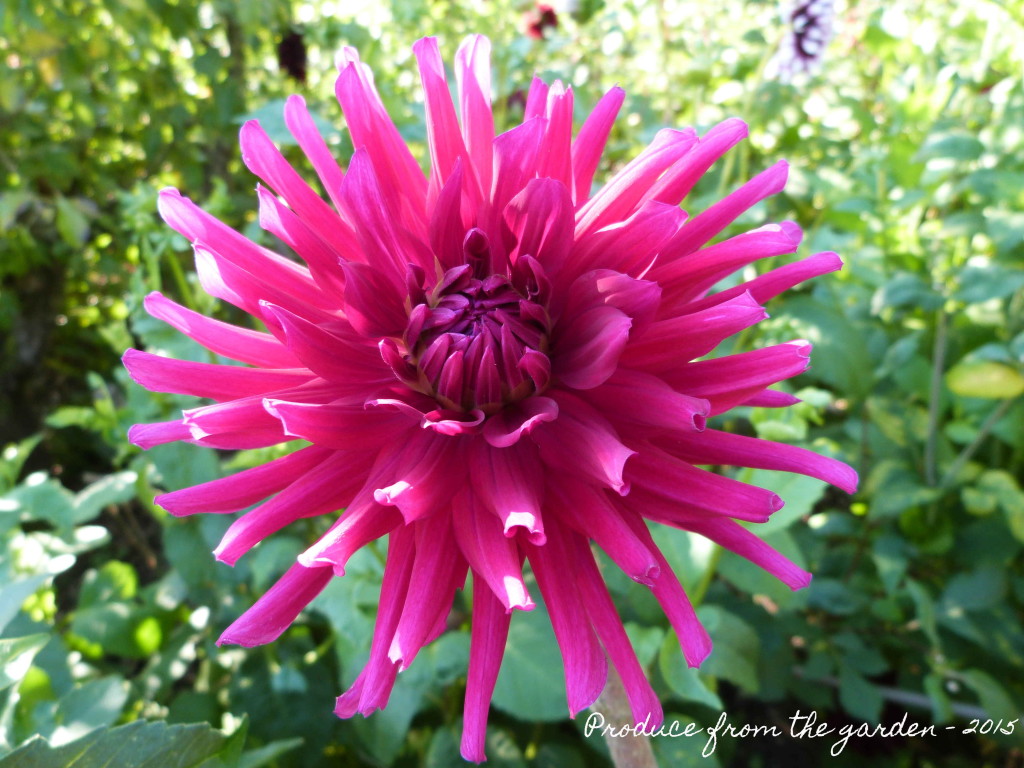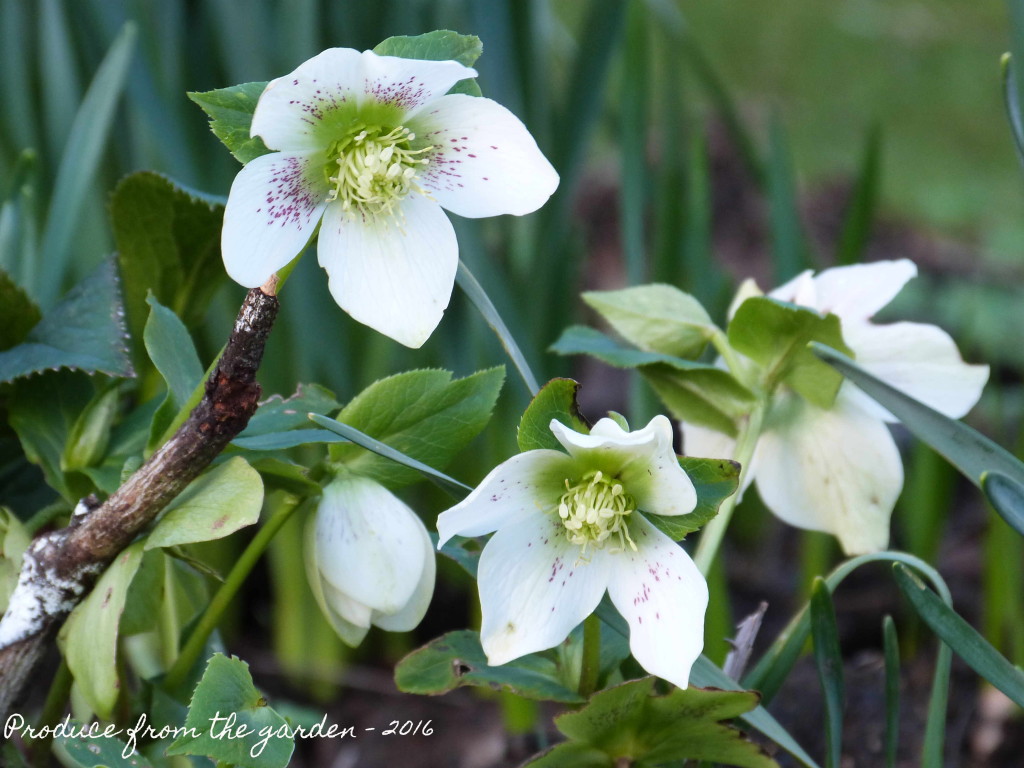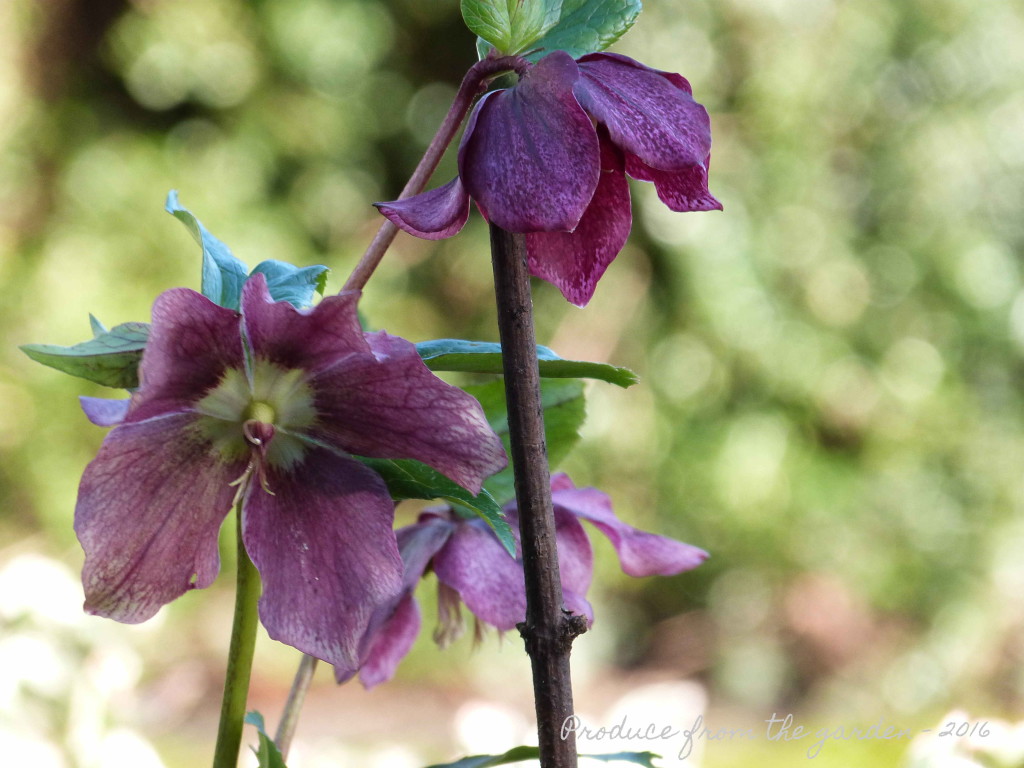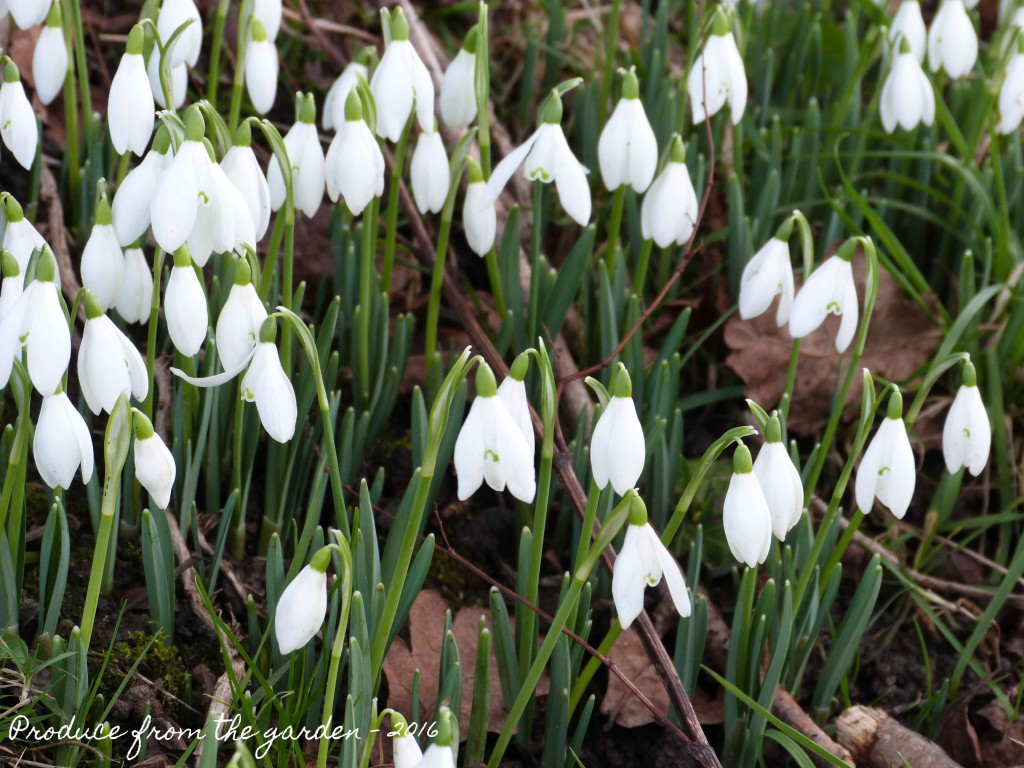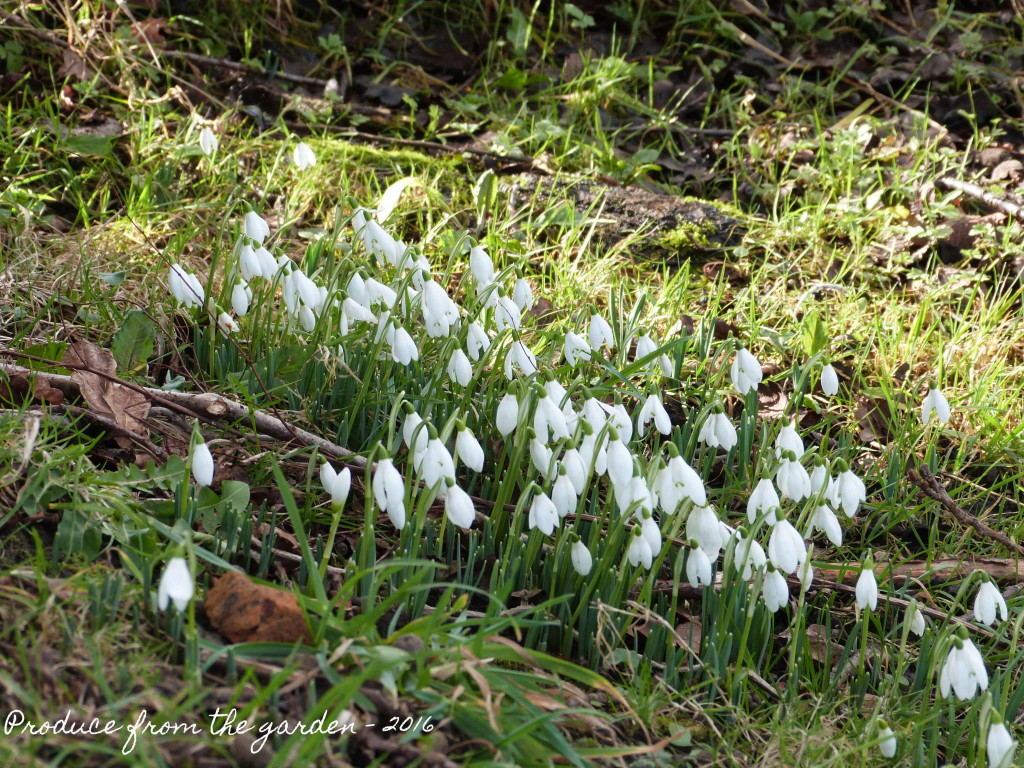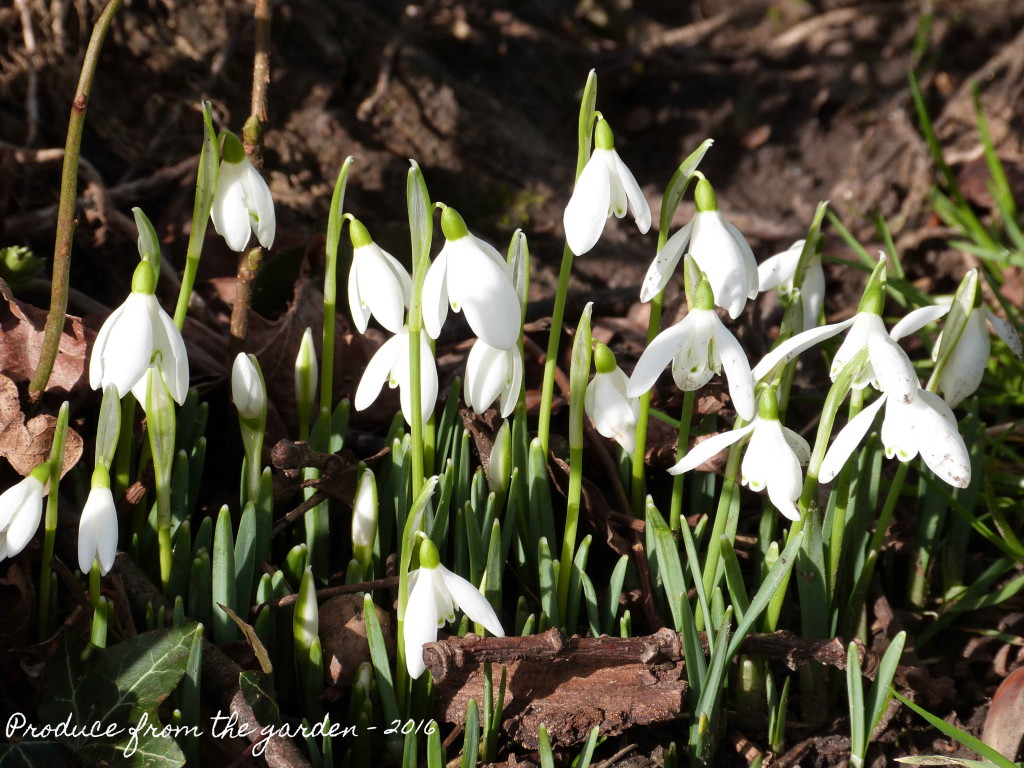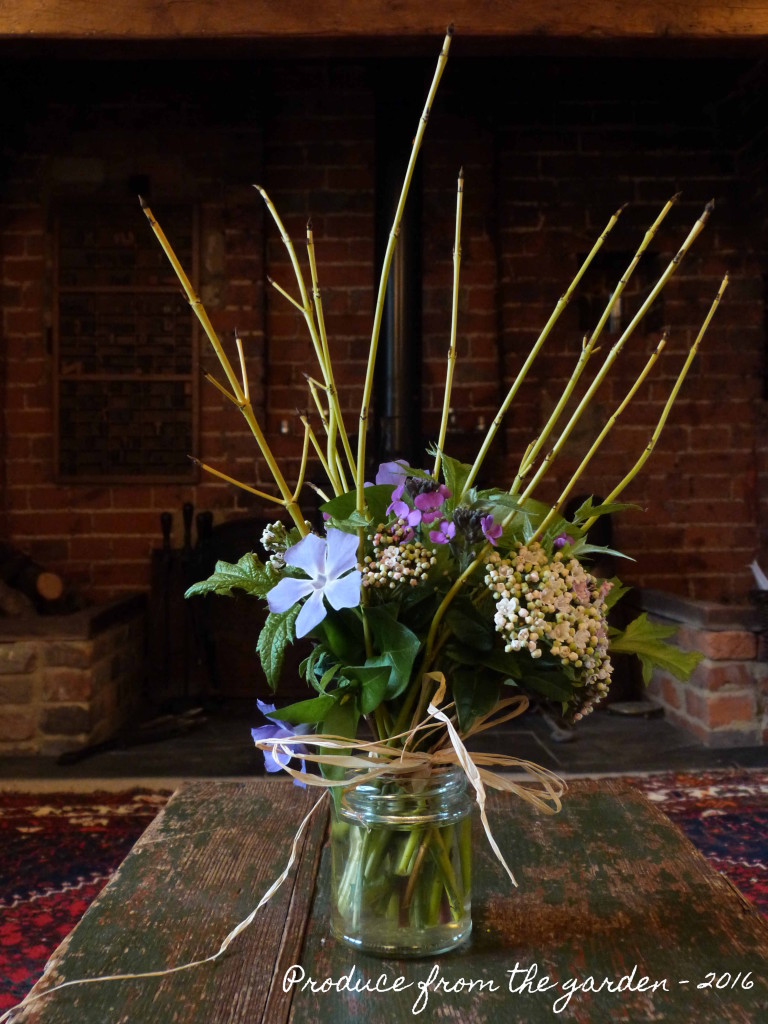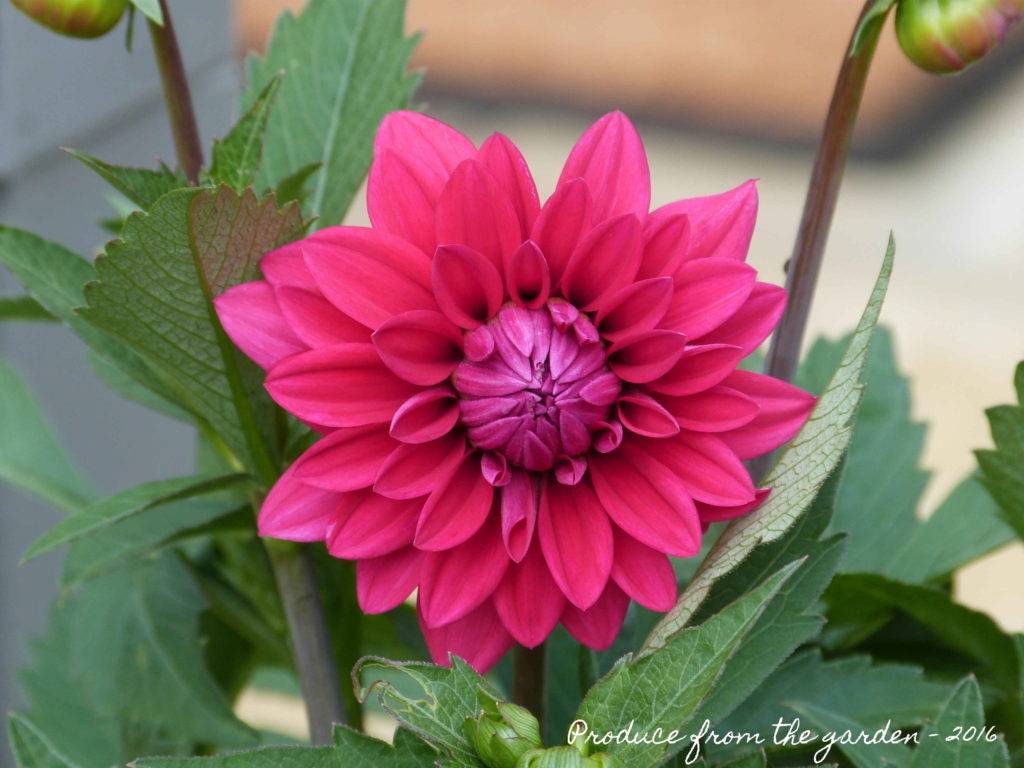 The First dahlia of 2016 and it’s a stunner! The variety is unknown as the tuber was kindly given to me by a friend who’d had a garden clear out. It’s currently residing in a pot as I’ve run out of dahlia space (there are secret plans afoot though, I just need to evict my children from part of the garden!). Currently a pot is the best place for dahlias; the slugs are worse this year than I’ve ever known. A mild winter has failed to keep their population to a manageable size; they’re decimating my dahlias that were left to overwinter in situ and munching through my squash and courgettes. It is therefore with great guilt that I have succumbed to slug pellets, sadly they have become essential. I was up at the crack of dawn after applying the dreaded lurid blue poison, collecting dead slugs before the birds got to them. I managed to fill two flower pots. It was a revolting job but it did seem to work, there have been very few slugs the following mornings and my treasured plants are looking better already. Fingers crossed using such horrid chemicals will not have impacted too much on the wildlife.
The First dahlia of 2016 and it’s a stunner! The variety is unknown as the tuber was kindly given to me by a friend who’d had a garden clear out. It’s currently residing in a pot as I’ve run out of dahlia space (there are secret plans afoot though, I just need to evict my children from part of the garden!). Currently a pot is the best place for dahlias; the slugs are worse this year than I’ve ever known. A mild winter has failed to keep their population to a manageable size; they’re decimating my dahlias that were left to overwinter in situ and munching through my squash and courgettes. It is therefore with great guilt that I have succumbed to slug pellets, sadly they have become essential. I was up at the crack of dawn after applying the dreaded lurid blue poison, collecting dead slugs before the birds got to them. I managed to fill two flower pots. It was a revolting job but it did seem to work, there have been very few slugs the following mornings and my treasured plants are looking better already. Fingers crossed using such horrid chemicals will not have impacted too much on the wildlife.
A May harvest from the kitchen garden
Whilst planting out Kale and sowing Dwarf French Beans, I noticed my first few Radish’s and Broad Beans of the year. They didn’t make it to the kitchen, a gardener’s perk! The young fresh flavours got me thinking about what we’re actually harvesting at the moment. So here’s a quick snapshot of the produce from the garden today.
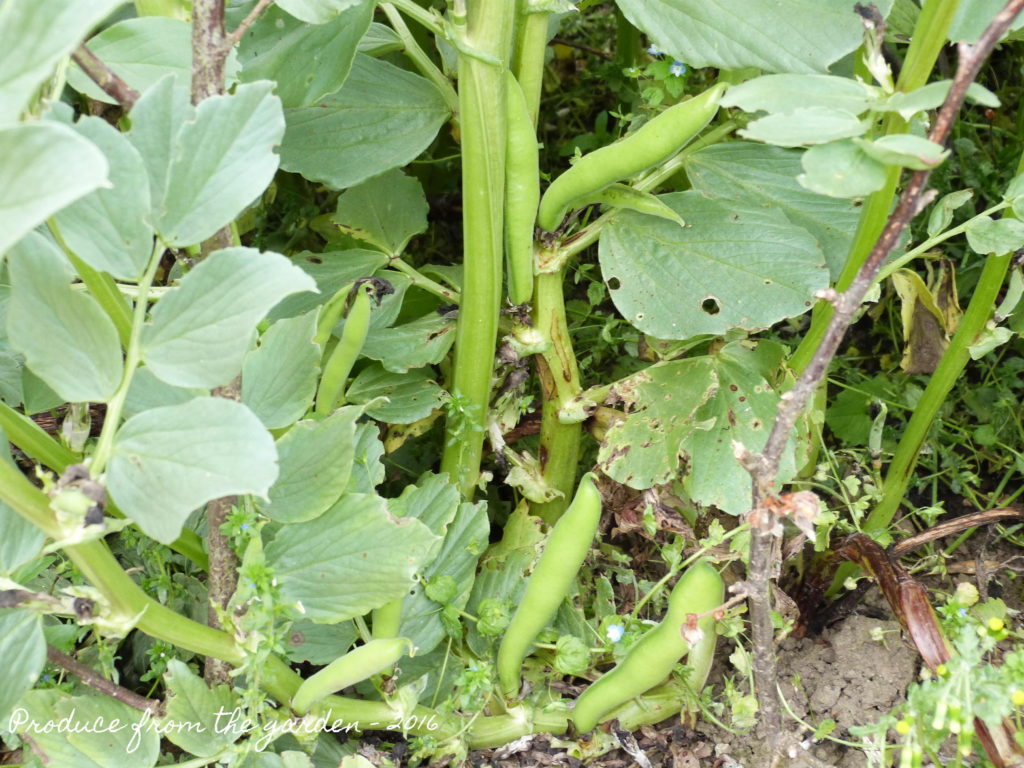 Broad Bean Aquadulce Claudia, I sow them in October for an early Spring crop, usually very successful unless we have an unusually cold winter
Broad Bean Aquadulce Claudia, I sow them in October for an early Spring crop, usually very successful unless we have an unusually cold winter
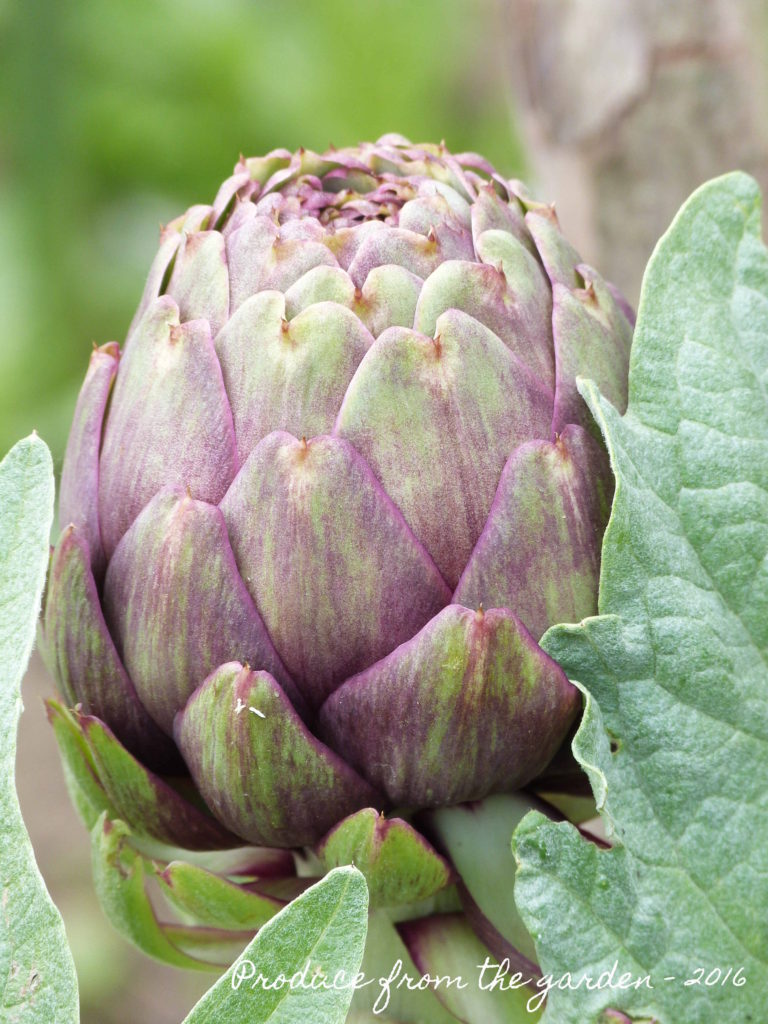 Artichokes, they look so beautiful I can’t bare to cut them yet.
Artichokes, they look so beautiful I can’t bare to cut them yet.
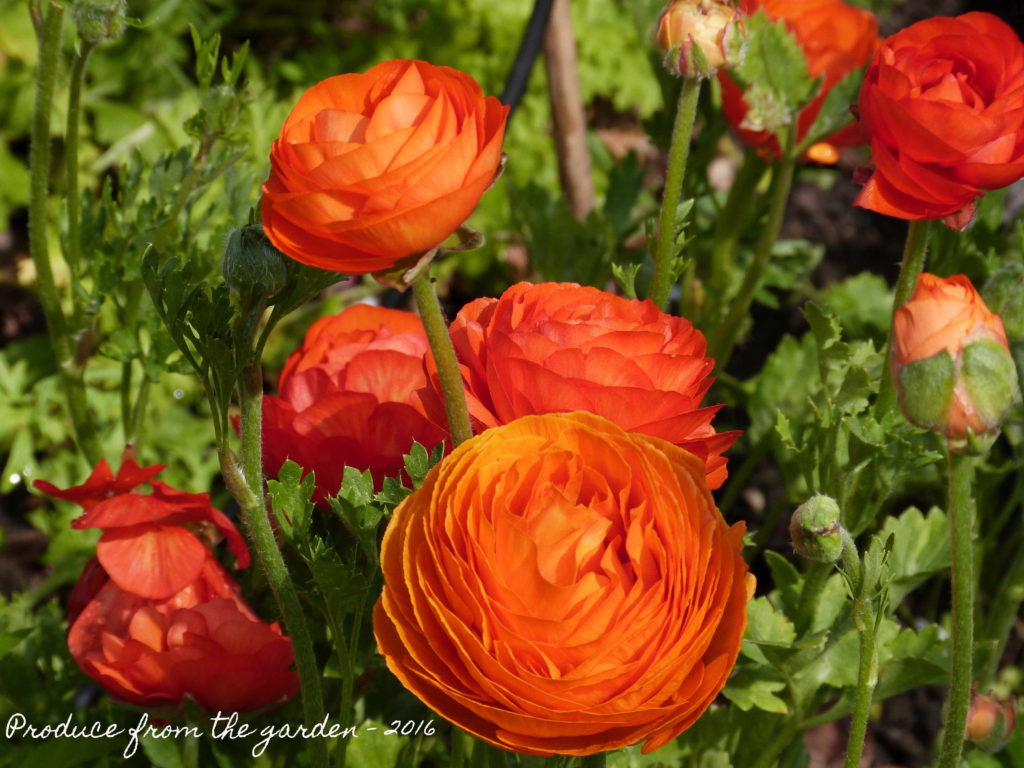 Ranunculus Aviv Orange, Zing! I can’t keep my eyes off them, an amazing cut flower.
Ranunculus Aviv Orange, Zing! I can’t keep my eyes off them, an amazing cut flower.
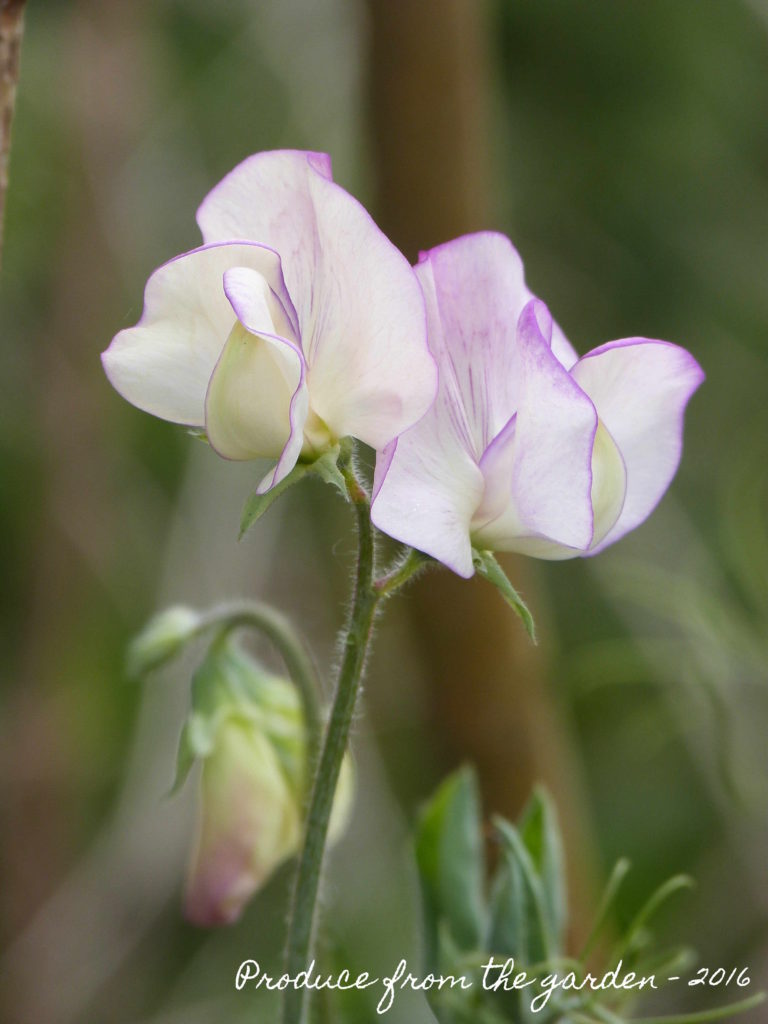 Autumn sown Sweet Peas, the summer floral scent is a refreshing change from the more intense and heady daffodil aroma I’ve got used to in the last few months
Autumn sown Sweet Peas, the summer floral scent is a refreshing change from the more intense and heady daffodil aroma I’ve got used to in the last few months
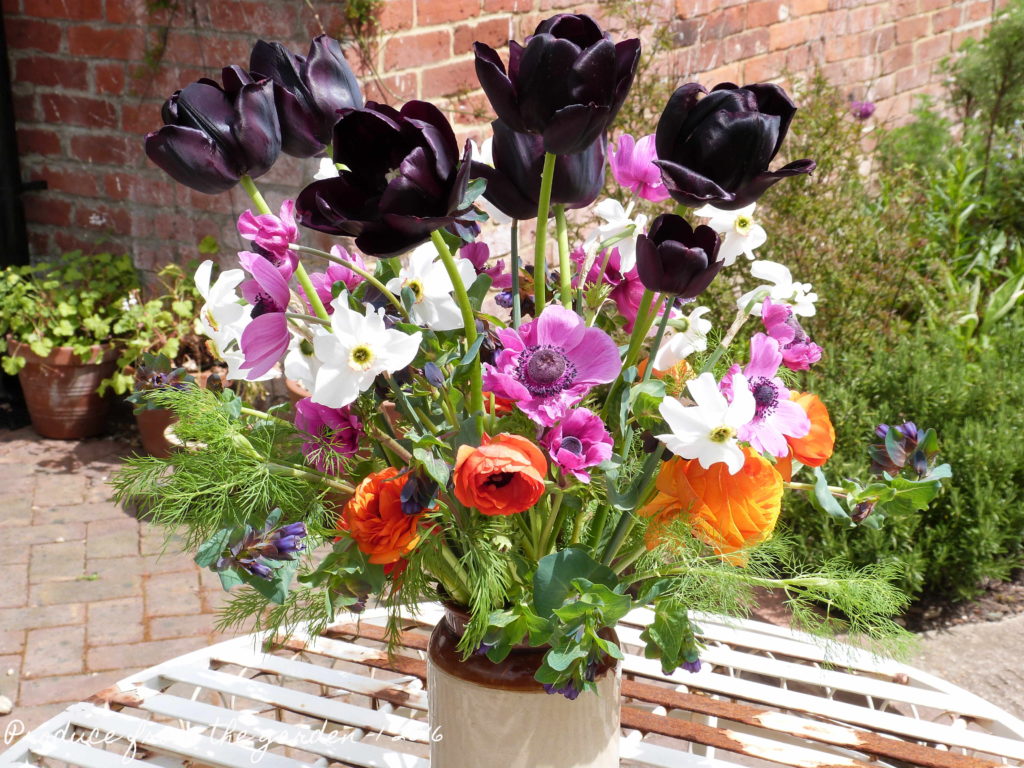 Flowers from the cutting border. It was only when up loading this picture that I realised how ridiculous the tulips look, they’ve now been reduced in size and popped back into the arrangement below! I’m far from a natural florist!
Flowers from the cutting border. It was only when up loading this picture that I realised how ridiculous the tulips look, they’ve now been reduced in size and popped back into the arrangement below! I’m far from a natural florist!
How to build a cutting garden for less than £100.
My second and final (thank goodness) Spring project is complete. The first was landscaping, tidying and grass seeding our main lawn. The second has been creating a cutting garden in an area which contains our septic tanks (oh the joys of living in the middle of no-where). I can only describe this section of front garden as wasteland, and I must confess I have been hanging my head in shame at the thought of friends and neighbours seeing it and thinking ‘…and she calls her self a garden blogger!’.
I started the cutting garden by marking out the shape of the raised beds with canes which can be seen in the picture above. I then measured and ordered the wood.
Once I had cleared the area of roots I then levelled the raised bed section and built the wooded frame. For details on how to make a raised bed do take a look at the video I made last year.
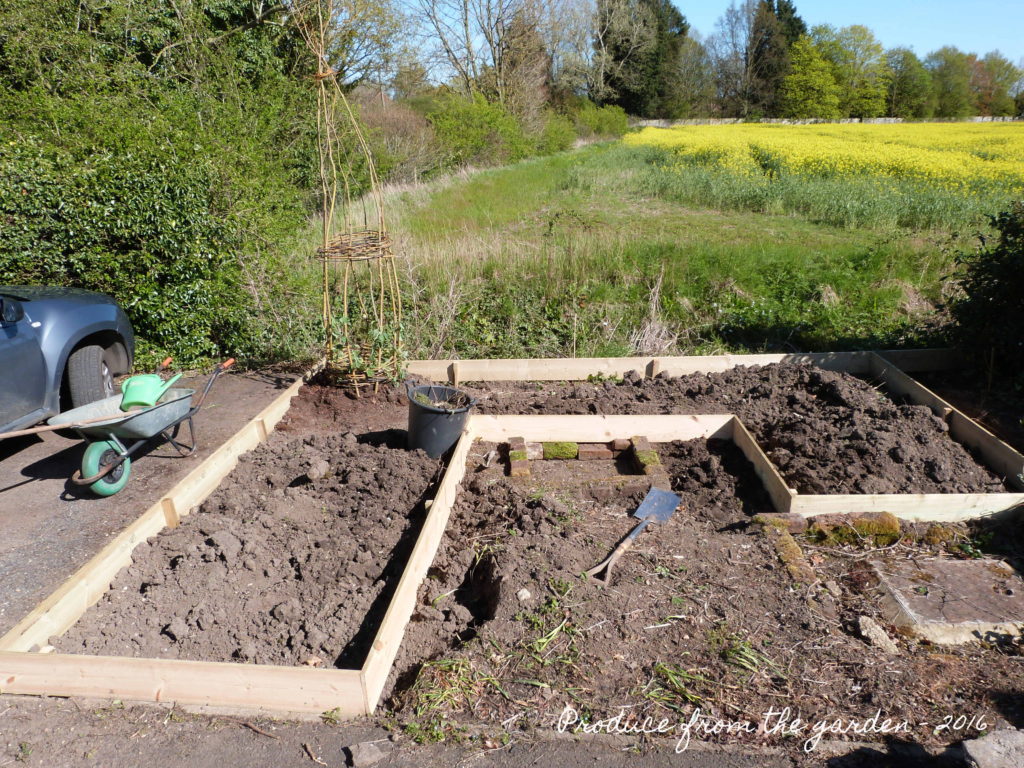 Half way there! The completed raised bed frame.
Half way there! The completed raised bed frame.
I then dug out the surrounding area and used the excess soil combined with garden compost to fill the raised beds. Finally I put down weed block and covered with pea single.
Wood used came to £40 and a meter square sack of pea shingle £45. The obelisk I made from our coppiced willow is in pride of place, sweet peas sown in autumn are happily beginning to clamber up it. I can’t wait to fill the rest of the raised bed with dahlias and annuals. With the lovely warm weather we’re enjoying it’s tempting to plant up this weekend, my gut feeling says we’ve seen the last of the frosts in Kent.
After planting I will hammer in hazel stakes and hang pea netting to them. This will give support to the annuals encouraging lovely long straight stems for cutting. The lurid green netting looks dreadful to start with but the annuals soon grow through it covering the green plastic.
A bunch of Spring flowers
Anemone De Caen ‘Sylphide’
Flowers from the garden for an Easter Wedding
I’ve had great fun arranging flowers from my garden for a spring wedding. I’ll let the pictures tell the story.
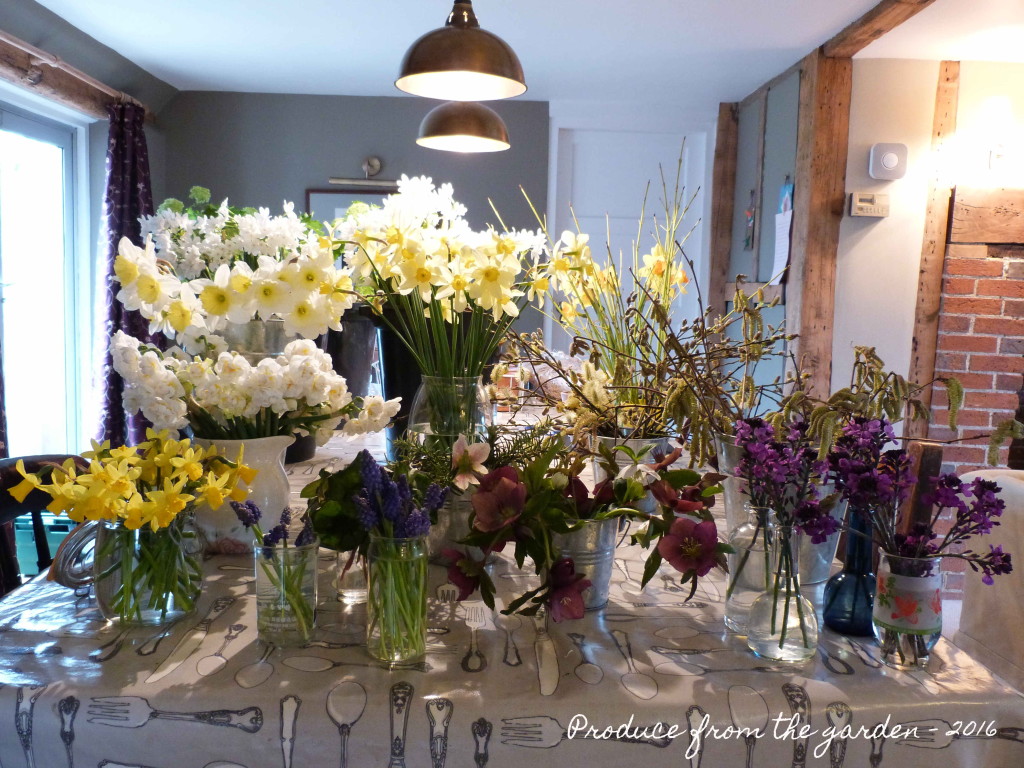 Flowers picked, conditioned and grouped on my table ready for arranging
Flowers picked, conditioned and grouped on my table ready for arranging
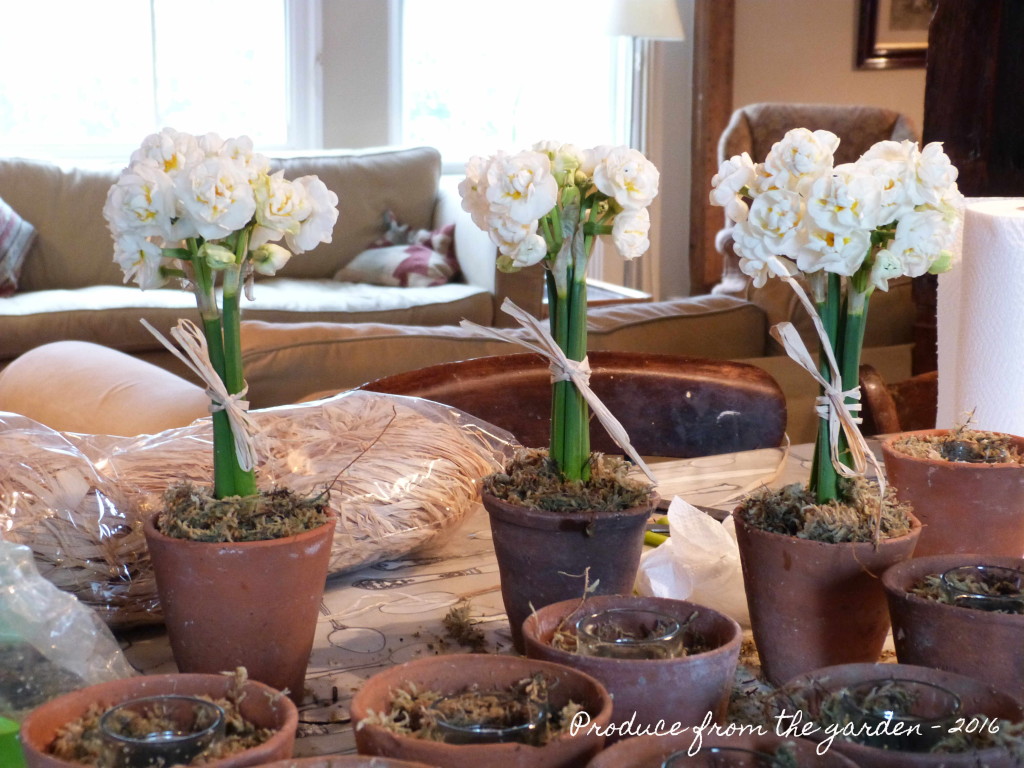 Narcissus Bridal Crown arranged in flower pots for the reception table
Narcissus Bridal Crown arranged in flower pots for the reception table
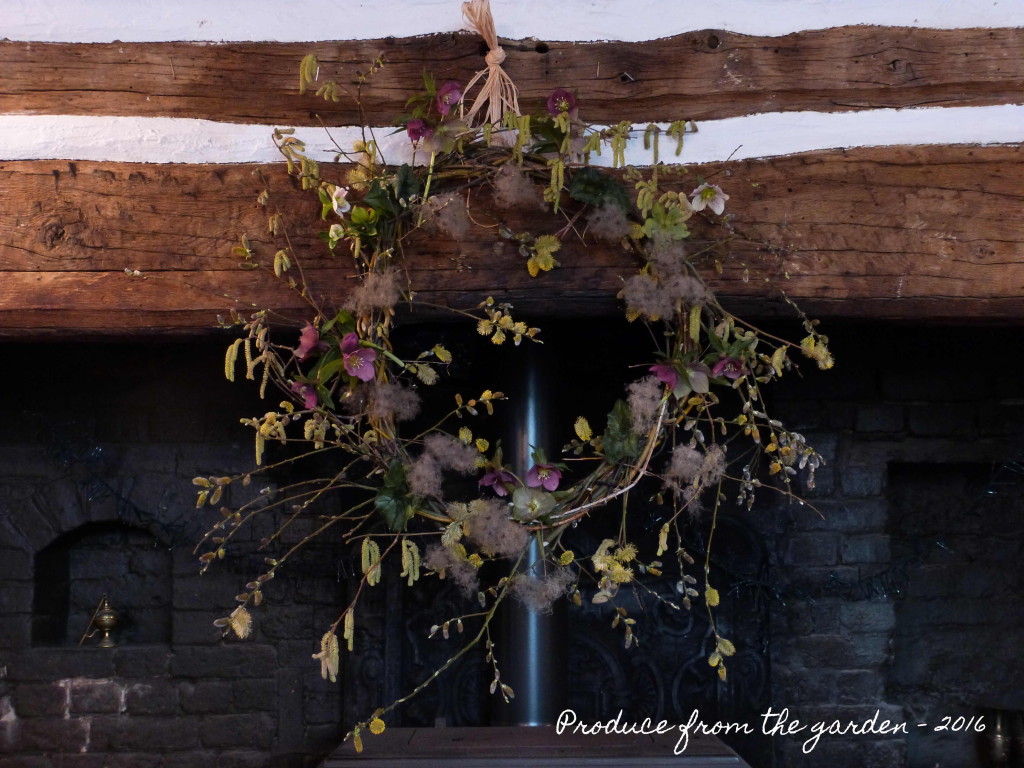 A bridal Spring wreath hanging over an inglenook fireplace, weaved Willow, Catkins, Pussy Willow, Old Mans Beard, Cyclamen leaves and Hellebores
A bridal Spring wreath hanging over an inglenook fireplace, weaved Willow, Catkins, Pussy Willow, Old Mans Beard, Cyclamen leaves and Hellebores
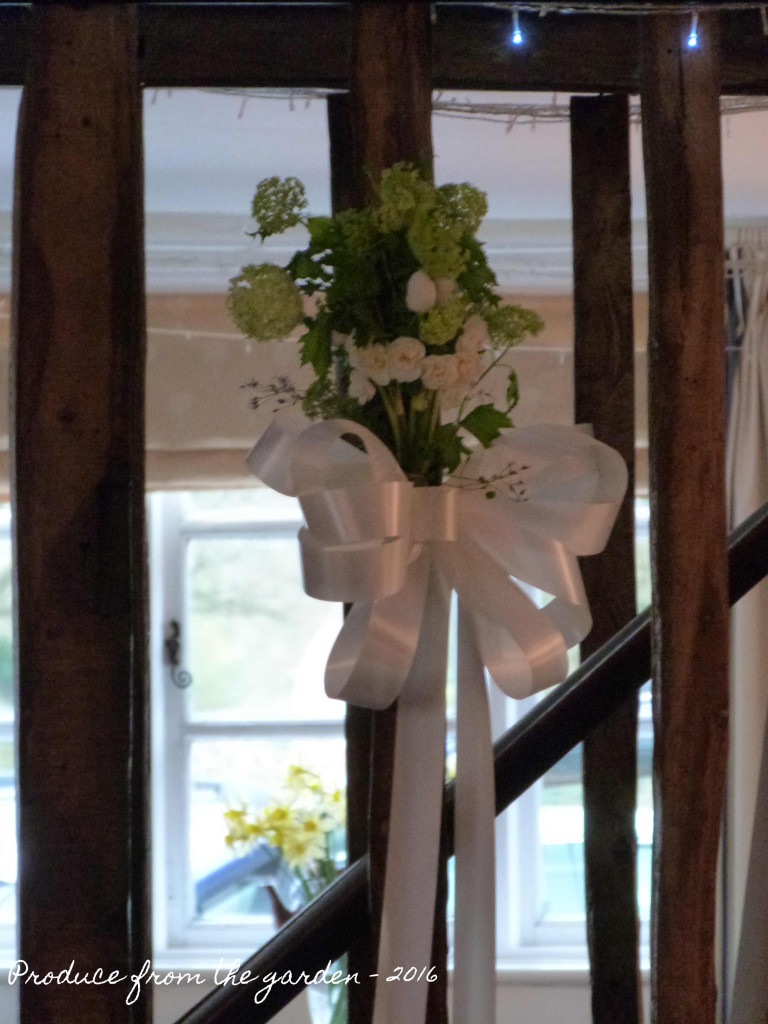 Wedding wall bows with Viburnum Opulus, Narcissus Bridal Crown, white scented Pelargoniums and white Tulips
Wedding wall bows with Viburnum Opulus, Narcissus Bridal Crown, white scented Pelargoniums and white Tulips
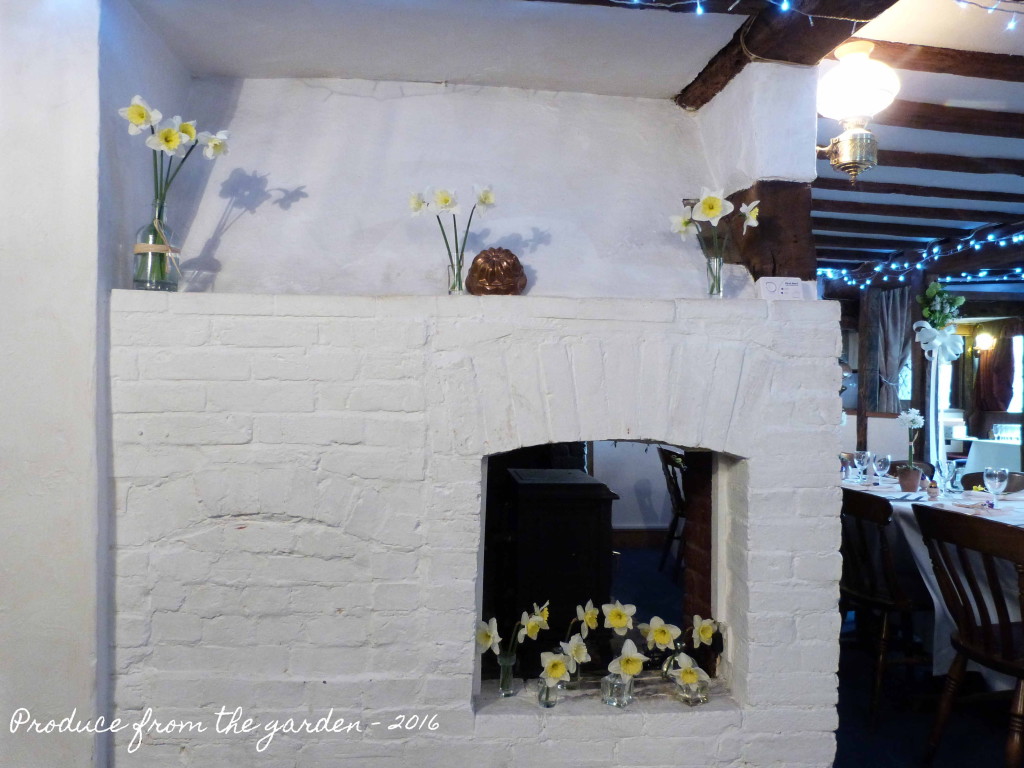 White wedding daffodils in the nooks and crannies
White wedding daffodils in the nooks and crannies
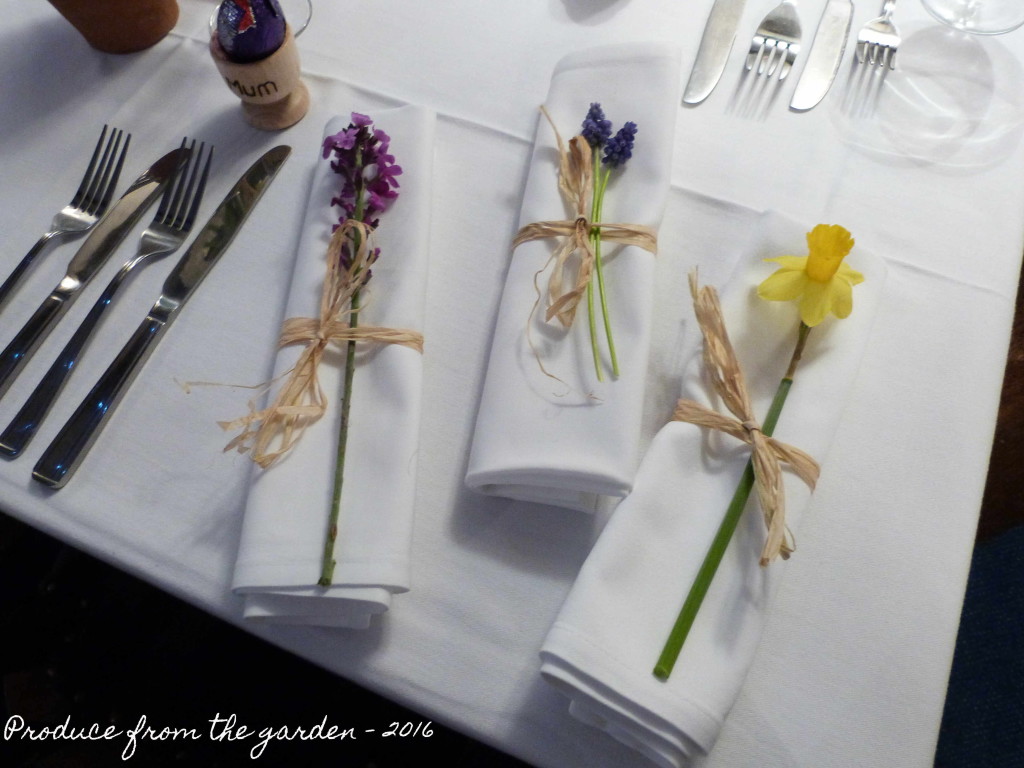 Wedding napkins, Wallflower Bowles Mauve, Muscari, Narcissus Tete a Tete all giving colour to the tables
Wedding napkins, Wallflower Bowles Mauve, Muscari, Narcissus Tete a Tete all giving colour to the tables
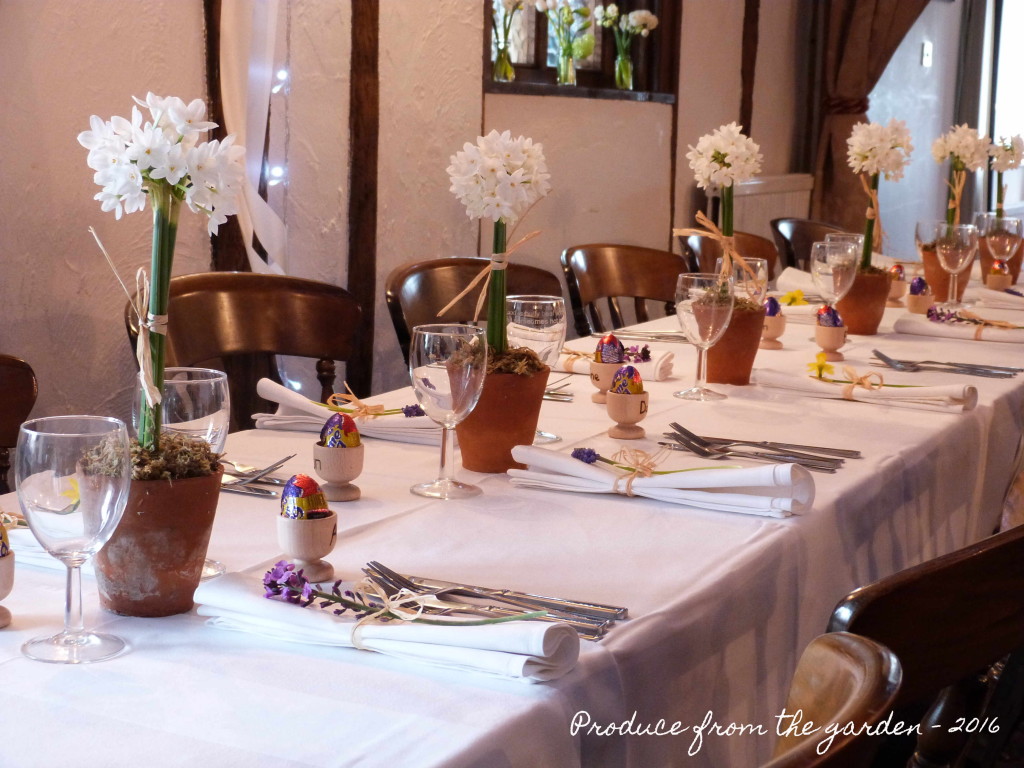 The wedding tables with Narcissus Paperwhite in pots
The wedding tables with Narcissus Paperwhite in pots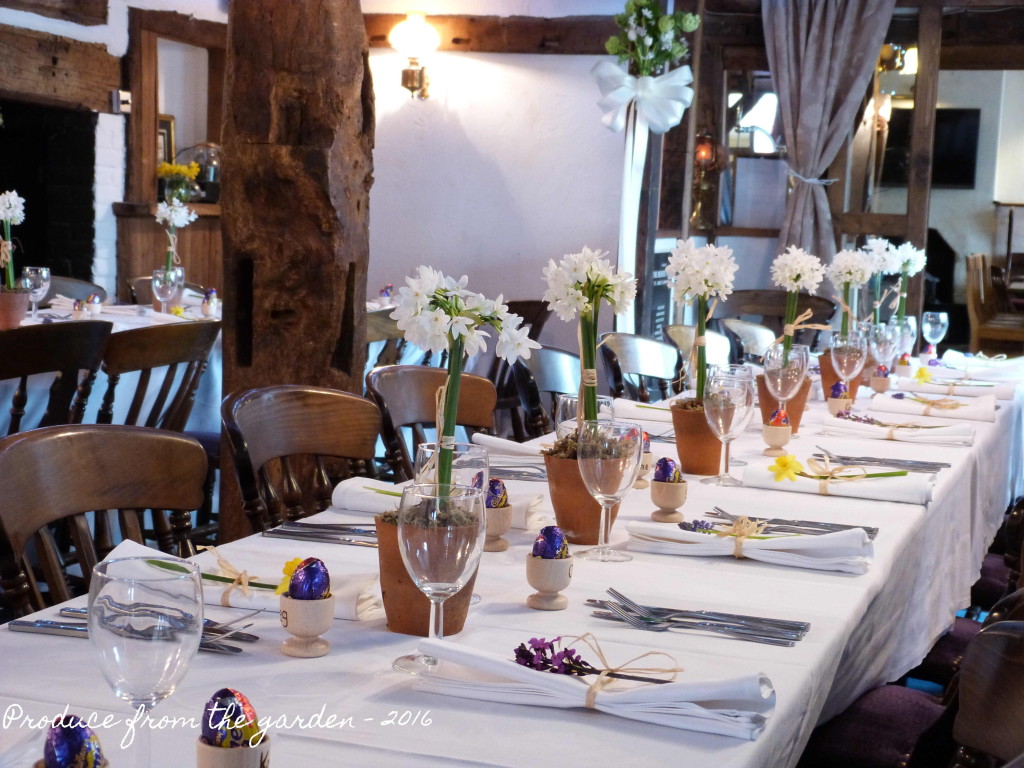 One of the reception tables
One of the reception tables
My top three garden cut flowers
In our home cut flowers are as important as pictures on the wall. They bring a room to life with their colour and scent. Buying from a florist is beyond our budget and more reasonably priced supermarket flowers are generally shipped from Africa, have no scent and are often only available in insipid colours. The solution? We grow our own cut flowers, filling our home with beautiful blooms for most of the year for very little money. Most flowers ideal for cutting are ‘cut and come again’, the more you cut the more they flower!
Let me inspire you to sow a few seeds or plant a tuber so you can cut your own flowers this year.
With the help of my all time ‘Top 3 Cut Flowers’:
No. 3 Sunflowers
Who can argue with the likes of Monet and Van Gogh immortalizing vases of Sunflowers on canvas. A beautiful bunch of Sunflowers brings the warmth and richness of high summer into our homes. Even on a wet gloomy English Summer day! Easy to grow, they are often the seed of choice for schools. There are lots of Sunflower varieties ideal for cutting. Once the lead stem and flower is cut, it will induce growth, putting out multiple side shoots and flowers.
How to grow
Sow seed March to May in pots, not directly in the ground. They will germinate fine directly sown, but, slugs love baby Sunflower plants! Pop one seed into a medium sized pot, allowing sufficient space for growth. The Sunflower stem needs to establish a strong pencil sized thickness to survive slug attacks. Choose a sunny position and plant out in mid May after the last frosts. Hammer in a tall stake or sturdy cane next to each plant; they will need regular tying in to prevent the stem being damaged on a windy day. Six plants will provide you with armfuls of flowers through summer to the first frosts.
Displaying
Sunflowers look fabulous in a vase on their own or mix with other statuesque flowers. They can also be used as the star performers in a bouquet.
Recommended varieties to grow
Earth Walker, Red Sun, Valentine and Deep Red
No. 2 Cosmos
A cottage garden essential and the hardest working annual in the garden. A bunch of Cosmos on the kitchen table is the epitome of produce from an English country garden. This delicate looking stunner is a flower straight from a child’s imagination, depicted in their drawings. Easy to grow and available in white or any shade of pink.
Cosmos are half hardy annuals so it’s best to sow them under glass or on a window sill. Sprinkle a few seeds into a pot of seed compost and cover with a thin layer of the same compost. I sow double the number of seeds I need. Most will germinate. It’s all too easy to sow too many ending up wasting seedlings and seed that can be used the following year. Once the seedlings start to get their first set of true leaves pot them on into individual pots where they’ll thrive. Plant out after the first frosts choosing a sunny site. Stake or secure a pea netting framework over them to provide a supporting structure when they’re large plants. Keep well watered through the summer and you’ll be rewarded with bountiful flowers.
Displaying
I love a big bunch of Cosmos on the kitchen table. They also look beautiful in a posy with other cottage garden flowers.
Recommended varieties to grow
Cosmos Purity, Cosmos Bipinnatus ‘Rubenza’, Cosmos Bipinnatus ‘Dazzler’ and Cosmos ‘Double Click Cranberries’
No. 1 Dahlias
I’m a bit potty about Dahlias. Every year I always sneak a few new varieties into my potting shed! These beauties are the stars of the ball. They come in many different shapes, sizes and colours and they all put a great big smile on my face. A single £2.50 tuber will reward you will with masses of flowers from early summer to the first frosts for years. Sadly they’ve acquired a high maintenance reputation which I would like to dispel.
How to grow
Make sure the tubers you buy are firm and not squishy. March to April plant them in a 3 litre plastic pot. After a few weeks they’ll start to shoot. If you get more than 5 or 6 shoots, remove them giving space for the others to develop into a bushy plant (removed shoots make successful cuttings). By mid May after the last frosts you’ll have a strong bushy plant ready to put out. Choose a sunny site for them and build a sturdy frame (I use hazel stakes) around the Dahlia to protect from wind damage. Once they start flowering keep picking. Letting flowers go to seed will halt flower production. After the first frosts cut the Dahlias back and cover with a thick 20 cm mulch (rotted manure, wood chip or anything that will help insulate the tuber over winter). Come Spring reduce the level of mulch and feed. As the soil starts to warm Dahlia shoots will emerge again. This low maintenance Dahlia method has worked for me during the coldest of Kent winters.
Displaying
Stunning as single stems in a small vase or bottle. Group together, or use in a mixed arrangement.
Recommended varieties to grow
All of them!
Hellebores
Hellebores are in full bloom. They’re the sophisticated, slightly shy understated belle of the ball. Hellebore colours are tastefully muted and absolutely stunning, nature has an amazing knack of creating the most perfect colours, not even a Farrow & Ball or Little Greene paint colour chart has a patch on the real thing! To fully appreciate their perfect profiles you need to lift their shy heads up to reveal their complete beauty. They’re a fabulous cut flower at this time of year, instead of popping them in a vase, float them in a bowl to display them at their best.
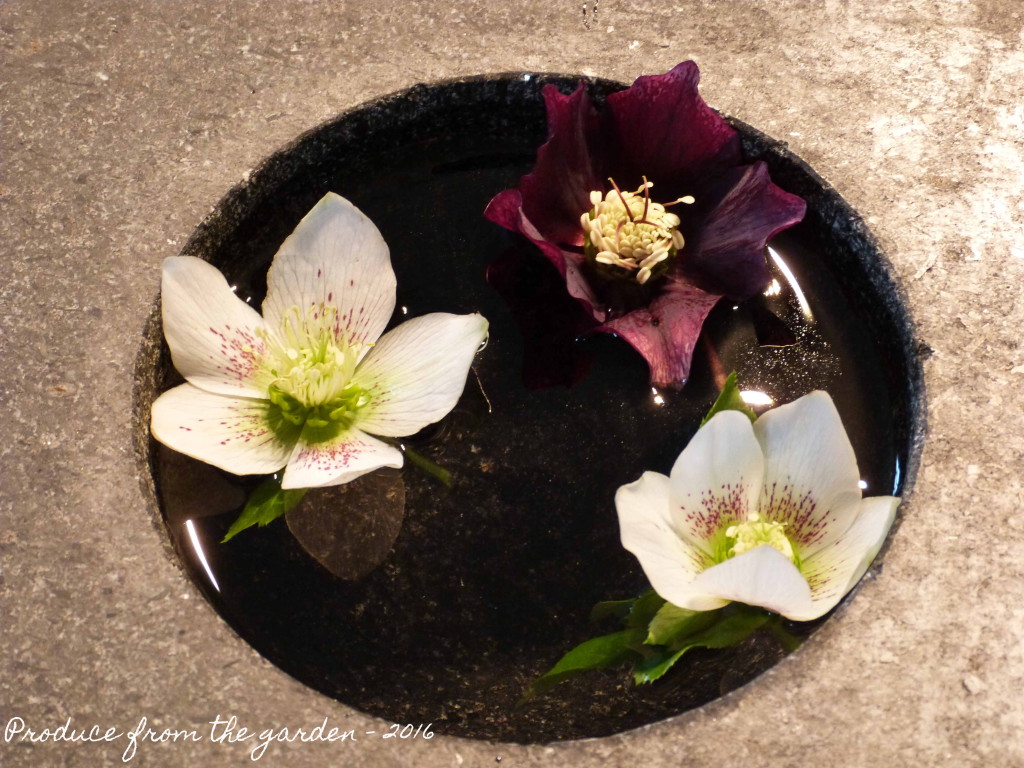 Hellebores a fabulous cut flower floating in a bowl, fingers crossed the husband not after his pestle and mortar in the next few days!
Hellebores a fabulous cut flower floating in a bowl, fingers crossed the husband not after his pestle and mortar in the next few days!
There were no hellebores in the garden when we moved here; I brought some seedlings with me which are now rewarding me with their gorgeous flowers. Keep an eye out when weeding around Hellebores, they’re generous self seeders. I just dig up the seedlings and replant them somewhere in dappled shade; they will flower in two years time, well worth the wait as sometimes they’re the same as the parent plant but often a completely different colour and form.
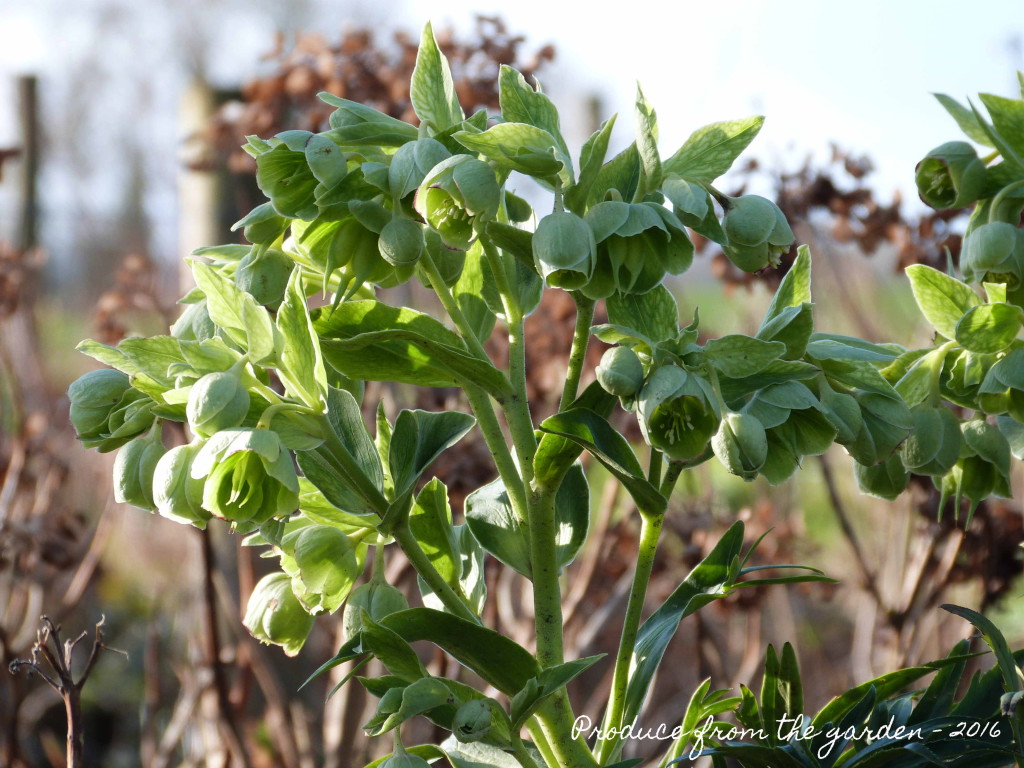 Stinking Hellebore (Helleborus foetidus), a great acid green colour, yet to noticed the smell
Stinking Hellebore (Helleborus foetidus), a great acid green colour, yet to noticed the smell
